How to Create a Powerful Hoax (and Why We Need to Know)
Graphic Design: Krizia Angelina
One year ago, we read news about the Muslim Cyber Army and Saracen. They are known for their ability to formulate strong and convincing false informations or popularly known as hoaxes or fake news. They use strong dictions, interesting logic, powerful imagery, and sometimes audio or video to bolster the arguments in their hoaxes. As a result, there are a lot of people who clicked on their links, read, and believed in their information.
In addition to their political content, the creation of the Muslim Cyber Army and Saracen is economically motivated. This group is sustained and is able to survive because they can generate money from Google Ads on their website. There are also strong accusations that they have received funding from a certain group, even though not yet proven in court.
Nevertheless, so what can we do to avoid such fake news?
There is no one way solution to avoid fake news because the creators evolve and use many strategies to create a “better” fake news. Therefore, to avoid them can be quite a challenge. However, we are able to learn the way they manufacture fake news and learn their tactics, making us immune and unaffected. Eventually, we can be wiser in reading information on social media and, in the end, keep our sane minds.
Manufacturing a “believable lie” requires talented writers and creativity in presenting said lies. Advertising is actually one of the many examples of creative lies. It highlights and exaggerates the features on a product and attracts the viewer to know how great the product is and eventually leads viewers to the stage of transaction. This theory is commonly known as AIDA (Attractive, Interest, Demand, and Action), the same theory that applies to manufacturing fake news. The information must attract attention, it must serve the interest of the viewers, demanding them to believe it. The last action from the viewer would be to either share, like, and/or comment on the piece of information. In short, manufacturing a hoax may mimic the AIDA theory which is commonly used in creating an advertisement.
There are five steps in manufacturing a hoax. First, we must pick a theme. There are five types of hoaxes: Scientific, Cryptozoological, Parapsychological, Religious, and Political. Here are the examples of hoaxes from each mentioned theme:
Scientific: Planet Nibiru, Flat Earth
Cryptozoological: Big Foot, Yeti, Fiji’s Mermaid, and Loch Ness
Parapsychological: Alien Abduction, Flying Saucers
Religious: April 23 Doomsday (numerology)
Political: No Global Warming, Jokowi with DN Aidit
The second step is to craft a story. The story should seem real and look like a news piece with exact details that answer the five “W” questions (Who, What, Why, Where, and When). Moreover, using strong dictions to touch the emotional side of a person such as anger, fear, sadness, happiness, disgust, and surprise helps to gain more attention. The third step, is to add more credibility to your story like adding a photo, audio, or video file. After finished crafting a credible hoax story, the fourth step is to share on a personal blog site, such as Facebook, Instagram, etc to let the public read it. Finally, watch your hoax gain momentum. A “good” hoax story will lead to massive visitors or followers on your personal site.
I would like to close this entry with a teaser about the reason why people create hoaxes. The answer is to make money from Google Ads on their sites and sell endorsement services on social media. To make good money out of Google Ads and endorsements requires massive online visitors or followers. Otherwise, there is not enough money to make. Therefore, the hoax creators must craft a good hoax story to attract more people, serve the interest of their viewers, create a demand from the viewer to like, share, and/or comment. Each time a hoax story is liked or shared, more people will be able to read it and some of them may also believe it, thus the evil cycle is hard to stop. Therefore, by knowing the way to create a good hoax story, we can learn and be wiser when reading any news on social media, making us think that “maybe this particular piece of news is not true” and signaling to us that we must not fall into lies.
